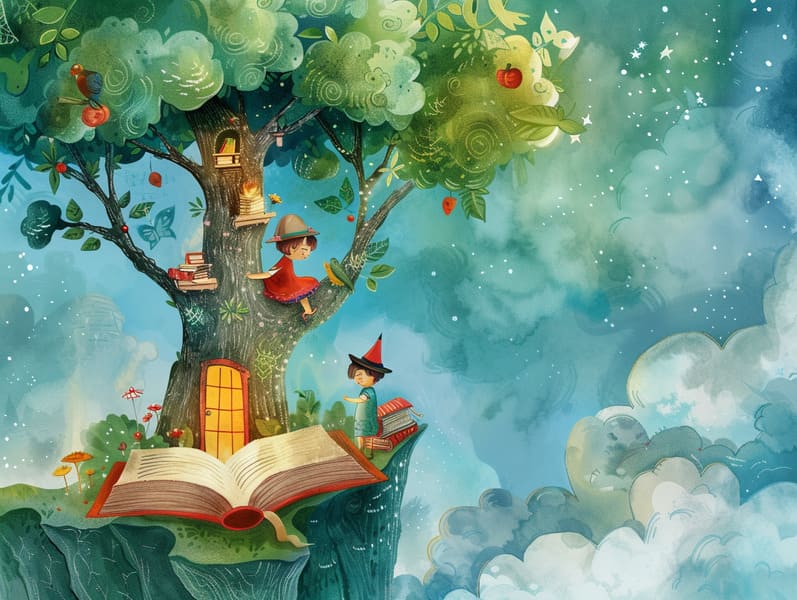
Children's fairy tales have timeless appeal. These tales have been transmitted from one generation to the next well before they were ever put on paper. They developed from a variety of civilizations, including Indigenous traditions. They were initially shared among older generations, often carrying themes and messages relevant to the societal norms and beliefs of the time.
The Brothers Grimm, Jacob and Wilhelm Grimm, were among the first to compile and publish many of these beloved narratives. Their published works, "Grimm's Fairy Tales," included stories like "The True Bride," "Little Brother and Little Sister," and "The True Story of Snow White," which have since become cornerstones in the world of traditional fairy tales. Similarly, Andersen's charming stories, such as "The Little Mermaid," and "The Ugly Duckling," have floated into hearts worldwide, cementing their place in the pantheon of famous fairy tales.
Despite being ancient, classic fairy tales remain as important as ever, especially as children's night stories. These charming stories are now available in multiple formats, including beautifully illustrated books, enchanting animations, and digital fairy tales.
Their lasting appeal can be ascribed to several enchanting factors:
Ethical Lessons: Traditional fairy tales often illustrate important moral lessons. Stories like "The Wolf and the Liar" teach the importance of truth, while "The Hare and the Tortoise" emphasize the values of perseverance and meekness. These narratives offer young readers clear distinctions between moral and immoral, molding their moral compass in a mild yet significant way.
Empathy and Understanding: Classic fairy tales frequently feature heroes facing struggles and tests, inspiring readers to resonate with their struggles and cheer for their triumphs. For instance, "Beauty and the Beast" conveys the value of seeing inner beauty to acknowledge the true nature of a soul, enhancing compassion and recognition.
Cultural Comprehension: Many fairy tales are infused with the cultural contexts from which they sprang. Delving into these tales can provide informative snapshots into different traditions, fostering a sense of global awareness and appreciation.
Inventiveness and Fantasy: The magical elements in traditional fairy tales—magical beings—promote children’s fantasy worlds. These fairy tales move readers to extraordinary realms, encouraging inventive thinking and a sense of awe that stays a lifetime.
Ancient fairy tales are not only whimsical but also edifying. They provide captivating tools in nurturing various brain and heart skills in the young. When timeless fairy tales are recited, they promote language skills by presenting new vocabulary and complicated sentence structures. This practice also fosters auditory perception and mindfulness, as kids concentrate deeply, prepared to see what happens next.
Furthermore, discussing the themes and characters of ancient fairy tales can nurture logical thinking and critical thinking. Kids are shown to discern patterns, forecast, and know cause and effect. These debates also boost little ones express their thoughts and feelings, nurturing their emotional intelligence.
In today’s electronic age, the abundance of online storybooks has made these fairy tales more reachable than ever. Digital sites and online apps present huge assortments of children's fairy tales that can be viewed or listened to anytime, anywhere. Fairy tales recited are particularly common, making available an delightful method for children to immerse in these fascinating tales. Narrated books and read-to-me videos lead characters and settings to life, often accompanied by charming harmonies and musical scores that boost the narrative adventure.
The timeless allure of ancient fairy tales lies in their ability to shift to present days while staying true to their main lessons. Contemporary updates of these narratives often introduce more varied characters and modern settings, making them accessible to today’s audience. However, the fundamental themes of braveness, humanity, and even-handedness remain unchanged, continuing to impact children of all ages.
Traditional fairy tales also offer a sense of protection and familiarity. They extend a neat narrative with a definite beginning, middle, and end, often wrapping up with the solving of conflicts and the triumph of good over bad. This uniformity can be reassuring for young ones, allowing a sense of solidity in an dynamic world.
Classic fairy tales continue to spellbind and educate new generations, maintaining their spell and impact in modern society. As website bedtime stories for kids, they grant access to a perfect blend of delight and instruction, facilitating moral values, empathy, and creativity. The abundance of online fairy tales and the well-liked nature of fairy tales narrated warrant that these classic narratives remain obtainable to new generations.
By sustaining and communicating these fairy tales, we continue to appreciate the rich tapestry of folklore and cultural heritage. Whether you are enjoying a gorgeously illustrated book, browsing a internet collection, or listening on an audio story, the magic of ancient fairy tales is always within reach. These fairy tales convey of the endless presence of fairy tales and its ability to unite us across centuries and lands.
Regardless if you are enjoying a vividly illustrated book, exploring a web collection, or listening through an read-aloud book, the radiance of timeless fairy tales is always within reach.
These tales illustrate of the persistent force of tales and its ability to gather us across centuries and lands, forming a connection that enchants and educates alike.